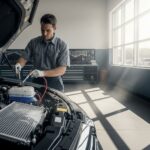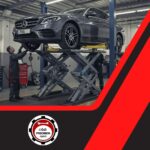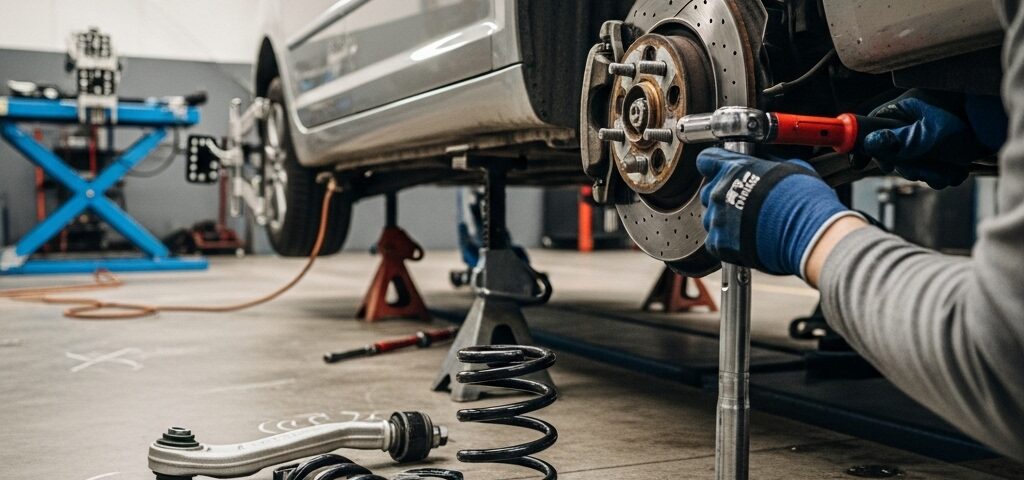
Preventive Auto Repair For Hot Weather In Thousand Oaks California
October 23, 2025
Get Back on the Road Faster with Certified Mercedes Benz Repair
October 27, 2025There’s a particular feeling when your car is right on the roads around Thousand Oaks. The wheel sits steady in your hands, the cabin stays quiet over expansion joints near Westlake Boulevard, and the pedal responds with calm confidence as you exit the 101 toward home. Brake and suspension systems do most of that heavy lifting, and they live complicated lives in our area. From the steady freeway cruise to the occasional spirited weekend run over Kanan or Decker, components face heat, load, and the tiny vibrations that add up over time. As a local technician who test-drives repairs from Newbury Park to Agoura Hills, I see the same patterns week after week—and I know how to address them before they grow into hassles. If you’re starting to research your options, a convenient place to begin is this Auto Repair that can guide your next steps.
Brakes and suspension don’t just keep you safe; they define how your car feels. A smooth, linear brake pedal tells you a lot about pad material, rotor quality, and caliper health. A composed chassis suggests bushings, dampers, and alignment are in harmony. When either system drifts out of tune, you notice it—maybe as a faint shimmy on the Hampshire exit ramp, or as a thump over the gentle swell on Lindero Canyon. The good news is that these systems are incredibly responsive to thoughtful maintenance and precise repair.
Brake feel in real-world Thousand Oaks driving
Our daily routes blend freeway speeds with surface streets, school zones, and parking aisles. That variety creates two main brake demands. First is high-speed stability: shedding 20–30 mph smoothly without vibration as you leave the 101. Second is low-speed refinement: quiet, predictable stops downtown or in mall traffic. Vibration at speed often traces to rotor thickness variation or pad material deposition. Low-speed noise or grabbiness can stem from glazed pads, dry slide pins, or corrosion where the pad backs meet the caliper bracket. We measure rotors carefully, clean and lubricate hardware, and choose pad compounds that balance bite with quiet operation.
Brake fluid plays a quiet but crucial role. As it absorbs moisture, its boiling point drops, which can lead to a soft pedal after long downhill stretches into Camarillo. Testing and replacing fluid at proper intervals restores margin. We also inspect hoses for micro-cracks and confirm ABS functions with a controlled stop on a safe stretch where traction allows—verifying that the system modulates correctly and returns the pedal to normal feel afterward.
Suspension: the language of composure
A well-sorted suspension makes the car feel effortless. Struts and shocks control motion; bushings guide geometry; springs hold the platform at the right height. In Thousand Oaks, subtle wear shows up as a float over rippled pavement near Lake Sherwood, a clunk over the uneven apron of a driveway, or a steering wheel that needs a gentle nudge to stay centered on the long straight past Westlake Village. We start with a visual inspection looking for fluid seepage at dampers, cracked or collapsed bushings, and play in ball joints or tie rods. Then we drive the car on a loop that includes freeway, side streets, and a curved on-ramp to feel how everything works together.
Alignment ties it all into a coherent whole. If you spend most of your time on the freeway, we’ll aim for a straight-tracking setup with modest camber that preserves tire life. If you enjoy canyon drives, we can sharpen turn-in a bit without making the car twitchy at speed. Tires tell the truth—edge wear, cupping, and feathering each point to specific adjustments or components that need attention.
Common concerns and how we solve them
Shimmy while braking from highway speeds is one of the most frequent complaints. The cure isn’t always new rotors; sometimes it’s cleaning the hub mating surfaces, torquing wheels correctly, or replacing a worn control arm bushing that lets the rotor wobble under load. Another common issue is a thump in the rear over small bumps. That can be a tired upper shock mount or a sway bar link beginning to loosen. We trace noises to their source with a combination of inspection, chassis ears, and patient road testing.
On SUVs and crossovers popular in Thousand Oaks, rear brake pads can wear faster than expected because of stability control strategies and towing. Front brakes get the attention, but rears deserve equal inspection. Trucks that see weekend work on Mulholland or the canyons may also benefit from specific pad compounds that tolerate heat while remaining quiet during the weekday commute.
Seasonal effects and local conditions
Summer heat changes the game. Pads can glaze in stop-and-go with the A/C blasting; rubber bushings soften slightly and transmit different vibrations. In cooler months, morning moisture can briefly coat rotors, causing a light scrape that disappears after a stop or two. Santa Ana winds add dust that finds its way into slider boots and onto rotors. Our service plans adjust with the seasons: pre-summer inspections that verify cooling for brakes and fresh fluid when needed, and post-summer checks that confirm bushings and dampers didn’t take a set during the hottest months.
Road surfaces matter too. The concrete slabs on some 101 stretches create a rhythmic thrum that can mask minor imbalances. Expansion joints near interchanges test bushing tightness and shock control. We test on those exact sections so your car feels settled where you actually drive.
Performance and comfort, both respected
Not every Thousand Oaks driver is chasing lap times, but everyone appreciates a car that responds cleanly. We can tailor brake pad choice to your priorities—some compounds offer strong initial bite for confidence, others favor the quiet and clean wheels many commuters prefer. For suspension, we consider whether adaptive dampers, sport springs, or OEM replacements fit your expectations. Often, the best result comes from restoring the car to how it felt when new, with careful attention to the small parts: bump stops, mounts, and the torque of every fastener.
When upgrades make sense—say, a slightly larger rotor package to improve heat management for a family SUV that sees weekend mountain trips—we’ll discuss trade-offs openly. The aim is harmony: a brake pedal that feels consistent whether you’re inching through school pickup lines or descending into Camarillo; a chassis that’s quiet over neighborhood imperfections yet confident on a Sunday drive across Kanan.
The road test standard
No repair is complete until it proves itself on the road. Our route includes a gentle cruise through Westlake Village, a highway merge and deceleration off Hampshire, and a sweep over the small undulations near Lakeview Canyon. We listen for clicks that might indicate a loose pad clip, feel for mid-corner stability that reveals bushing integrity, and perform quiet stops to verify low-speed refinement. If something isn’t perfect, we adjust before you pick up the car. That delivery standard is how we keep your errands and commutes calm and predictable.
For planning and comparison, you can also look at a concise resource like this Auto Repair to clarify what thorough brake and suspension service involves and what questions to ask.
Frequently Asked Questions
Q: What causes vibration when braking from freeway speeds? A: Often it’s rotor thickness variation or pad deposition, but loose hub mating surfaces, worn bushings, or improperly torqued wheels can contribute. We measure, clean, and test to pinpoint the cause.
Q: How often should brake fluid be changed? A: It depends on the vehicle and conditions, but testing moisture content during service visits tells us when to restore the boiling point. In our hot summers, fresh fluid provides valuable margin.
Q: My car clunks over small bumps—what should I check first? A: Start with sway bar links and shock mounts, then inspect control arm bushings and ball joints. We confirm on a road test that reproduces the sound.
Q: Are ceramic pads better? A: Ceramic compounds are often quieter and cleaner, while semi-metallic pads can offer stronger high-heat performance. The right choice depends on your driving and vehicle.
Q: Why does my steering wheel sit slightly off-center on the freeway? A: Alignment drift or worn tie rod ends can cause an off-center feel. An alignment set to your driving pattern and a check of steering components brings the wheel back to true.
Q: Do I need to replace rotors with pads? A: Not always, but rotors must be within spec and have an even surface. Many European and performance vehicles benefit from replacing as a set to preserve pedal feel.
Q: How do canyon drives affect suspension wear? A: Repeated cornering loads can accelerate bushing and tire wear. We tailor alignments and rotation schedules to balance weekday comfort with weekend fun.
Q: Can you road-test with me to hear the noise? A: Absolutely. A quick loop together helps us reproduce the issue and agree on the fix, saving time and ensuring satisfaction.
If your car has begun to feel a little busy on the freeway, or if a faint brake vibration is creeping into daily drives, let’s take care of it before it grows into a chore. We’ll inspect thoroughly, explain clearly, and road-test on your actual routes so the result feels natural the moment you pull away. Reach out today, share what you’re feeling, and we’ll map out a plan that fits your schedule. To connect with a trusted local resource and get started, follow this Auto Repair and take the simplest step toward a quieter, more confident drive.


